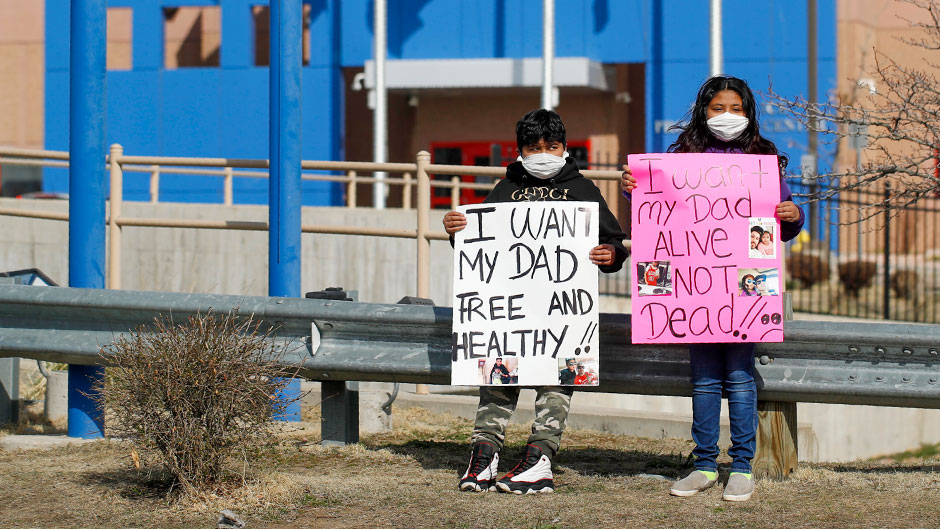The stark, white numbers on the black computer screen spin like a jackpot tally. Every day, they zoom up from zero, stopping on the new numbers that track COVID-19’s growing assault on our nation’s prisons.
As of June 11, the tabulation shows, 47,275 inmates and 8,819 correctional or detention employees have tested positive for the novel coronavirus; of them, 542 prisoners and 32 staffers have died.
Tomorrow, most of the numbers will tick upward, as they have almost every day since statistician Kathryn Nowotny, an assistant professor in the University of Miami’s Department of Sociology, and three other public health scientists launched the COVID Prison Project. Every day, the group tracks the pandemic’s impact on the roughly 2.7 million people who are incarcerated and the thousands who work in state and federal prisons and U.S. Immigration and Customs Enforcement detention centers across the nation and in Puerto Rico.
“There are not many people who care or do research about the health of incarcerated people,” Nowotny acknowledged. “But they should care because they deserve the same humanity as anyone else when it comes to health care. They are other people’s parents, spouses, children, brothers and sisters, or friends. And let’s not forget—prisons and jails aren’t closed islands. Correctional officers and other staff come in and out regularly and go home to their communities. So, what we see happening in the community is happening in jail and prison facilities, only to a greater extent.”
One of the few U.S. scholars who researches health care in prisons, Nowotny cites another reason, a legal mandate, why state and prison officials must care. Prisoners, she said, are the only population who have a protected right to health care, a right arising from a 1976 U.S. Supreme Court ruling which found that ignoring the medical needs of people behind bars violates their constitutional protection against cruel and unusual punishment.
Through their COVID Prison Project, Nowotny and colleagues from the University of North Carolina—Chapel Hill and Tufts University hope to provide the data and analyses that will encourage states to reduce the populations and adopt other measures to halt the spread of COVID-19 in their detention centers, which, by their very communal design, amplify the risks of exposure.
As Nowotny noted, people behind bars can’t practice the federal Centers for Disease Control and Prevention’s social distancing guidelines. Constantly surrounded by other people, they usually share small cells or large, crowded dorms. They are regularly searched and usually eat, shower, exercise, and even go to the bathroom in open, communal spaces. They can’t freely wash their hands and, in many facilities, have been forbidden from wearing face masks, which violate dress codes.
Often coming from marginalized communities, Nowotny said, people involved with the criminal justice system also have higher rates of smoking, HIV, heart disease, diabetes, and respiratory illness—all of the health risks that make people more susceptible to contracting and dying from COVID-19.
Just six weeks into publically reporting and analyzing COVID-19 data in state and federal detention centers, Nowotny and her co-investigators—Dr. Alysse Wurcel, an attending physician at Tufts Medical Center, and Lauren Brinkley-Rubenstein, an assistant professor of social medicine at UNC—Chapel Hill—pinpointed the states where the COVID-19 death rate behind bars exceeds the death rate in the general population. They believe this is a more useful comparison than tracking just sheer numbers of deaths.
Florida is among those states, but the difference—measured by comparing the deaths per 100,000 people in the general population to the deaths per 100,000 inmates in the incarcerated population—is significantly smaller here than in COVID-19 prison hotspots like Ohio, Michigan, and New Jersey. Florida’s prison death rate is a little more than 15 per 100,000 inmates, slightly more than the nearly 13 deaths per 100,000 people in the general population. In contrast, Ohio’s prison death rate is more than 156 per 100,000 inmates, nearly eight times the 20 deaths for every 100,000 people on the outside.
Nowotny cautioned, though, that the data is preliminary and subject to change as states increase testing and improve their reporting processes and procedures—which would make collecting the data far easier. Right now, that’s a painstaking and tedious task for the handful of students from the three universities who manually collect and update the data by visiting every state’s and the federal government’s prison websites every day.
“There is no uniformity at all. Every state is reporting information in different ways. Some report it by facility. Others report it statewide. Some information is really detailed; some is really lacking,’’ Nowotny explained. “We had to create a data dictionary and make strategic decisions on how we aggregate our four primary totals.”
With a $20,000 grant from the The Langeloth Foundation, which supports a more equitable and humane justice system, Nowotny said data collection will soon become more automated, allowing project investigators to focus on achieving their next goals. That includes collecting data from the thousands of county jails across the nation. Unlike in prisons, which house people who have been convicted of crimes, the majority of people in jail are held in pre-trial detention, often because they can’t afford to post bond.
Another goal, Nowotny said, is to make the website more interactive, particularly through data visualizations that allow prison reform advocates to easily spot troubling trends and prison officials to compare their facilities to others.
“We want prison officials to see what other states are doing—how many offer face masks, how many have increased sanitation procedures,” Nowotny added. “We want them to say, ‘Oh, other states are doing this, maybe we should be doing it, too.’ Prisons operate in isolation so it’s important for them to share information, too.’’

